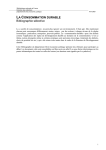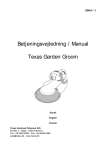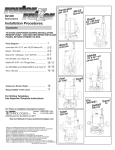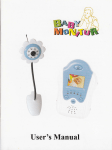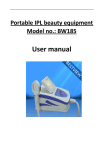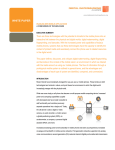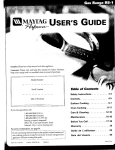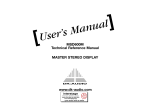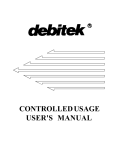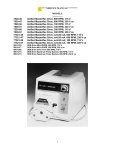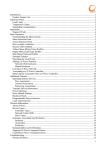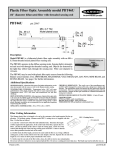Download Evaluation of the Raizer from Liftup
Transcript
KØBENHAVNS KOMMUNE Sundheds- og Omsorgsforvaltningen Center for Sundhed Evaluation of the Raizer from Liftup The City of Copenhagen's Sundheds- og Omsorgsforvaltningen (“Health and Care Administration”) has evaluated the Raizer from Liftup under the auspices of the Department for Sund Vækst (an organisation based in Copenhagen that develops and researches welfare technology). The evaluation took place between April and July 2015 at the Indre by/Østerbro Rehabilitation Centre in Hellerup, just north of Copenhagen. The results are reported in “Welfare Technology Evaluation (WTE) of the Raizer from Liftup”. The evaluation has been approved by the management of the Rehabilitation Centre, as well as by the departmental head of the Department for Sund Vækst. Ian Røpke Head of Department THE CITY OF COPENHAGEN Sundheds- og Omsorgsforvaltningen Afdeling for Sund Vækst Nørre Allé 41 DK-2200 Copenhagen Tel.: +45 2199 6449 Email: [email protected] Homepage : http://sundvaekst.kk.dk Afdeling for Sund Vækst Nørre Allé 41 DK-2200 Copenhagen N EAN 5798009290359 Welfare Technology Evaluation of the Raizer from Liftup 0.1 Carried out at Living Lab Strandvejen over May-June 2015 “It’s bloody neat!” (A test person) Table of contents Background and aims ...........................................................................................................................................3 Aims of the evaluation of the Raizer ................................................................................................................3 Technology .......................................................................................................................................................3 Data collection ......................................................................................................................................................3 Procedures/resources ......................................................................................................................................3 Test participants ...............................................................................................................................................3 Evaluation .............................................................................................................................................................4 Test persons .....................................................................................................................................................4 Organisation .....................................................................................................................................................4 Technology .......................................................................................................................................................5 Financial and resources ....................................................................................................................................6 Conclusion ............................................................................................................................................................7 Appendices ...........................................................................................................................................................8 Drawn up by P3 Social and health assistant students, Class 1311 – Continuous course in Welfare Technology. Pernille L. Hansen, Christina V. Intzilaki, Anette Moldow, Simone M. Rune. Educator: Mette R. Andersen. 2 Background and aims The Indre by/Østerbro Rehabilitation Centre (RCIBØ) offers 53 temporary 24-hour care places for people requiring rehabilitation. These people may have a physical disability and so experience mobility and balance issues. They may also suffer from mental and/or cognitive deficits and are thus not always able to assess their own abilities. Due to the above conditions, we experience a number of falls – both within the institution and in the areas surrounding it. During the evening and at night the institution is less well staffed than during the daytime. Until now helping people up from the ground has required a mobile hoist and accompanying lifting sling. Aims of the evaluation of the Raizer That the person can experience getting rapid and reliable help for falls. That the staff experience an improvement in procedures by being able to offer rapid and reliable help. That the staff experience an improvement in the physical working environment. To compare the Raizer with mobile hoists that were previously used to assist with falls. Technology The Raizer is a battery-powered mobile lifting chair. It helps a person lying on the ground/floor up assisted by one other person. The Raizer weighs 13 kg in total and is transported split across two carrying bags. It is recharged using a charger and an ordinary socket. The Raizer can also be recharged using your vehicle's cigarette lighter socket. Data collection We will use product guides and information from the manufacturers’ webpages in order to compare the Raizer and the Viking M mobile hoist. Procedures/resources We undertook qualitative interviews with night duty nurses and patient relocation supervisors concerning: Current procedures in the event of falls. The importance of the procedure and the physical working environment. Test participants Patient relocation supervisors. Night duty nurses. People wishing to assist with the evaluation of the Raizer. 3 Evaluation Test persons The Raizer was tested by two gentlemen, both with a BMI greater than 26. Person A was admitted to RCIBØ following a fall while pursuing a hobby. He was helped up by two paramedics. Person A had not previously fallen and required aids or others’ help to get back up. He weighs 112 kg. Person B had fallen at home during the night and was helped up by home care staff. Person B said that 3 people came and they used an aid by which "I got up and hovered". He weighs 98 kg. Does the Raizer meet the person’s needs? Both test persons agreed to lie on the floor and be lifted back up using the Raizer and by the help of one other person. After the test Person A said: “I was excited to see how such a slight girl and such a device with thin legs could get me up again.” Person B was surprised how quickly it went and that he didn’t need to “hover”. Both test persons agreed that the Raizer was a good way of getting back up again. Do the test persons wish to use the device? Both test persons wanted to use the Raizer, instead of being “pulled at by other people” (Person A). Both indicated that they felt calm and secure being raised from the ground by the Raizer. Are the people more independent thanks to this technology? No – the Raizer is not an aid that will compensate for a functional disability, but shall be used in the event of a fall. Does this device offer better quality of life? No – the Raizer cannot increase quality of life, but both test persons said that it was a more dignified way of getting back up after a fall. The care staff who were introduced to the Raizer also said that the method is more ethical than “the person hanging and dangling in a hoist”. Organisation Does this technology lead to a better working environment? Three out of four night duty nurses were introduced to the Raizer. All three said that if there was a fall during the night, they mainly use 2 people to lift the person up from the floor without any aids. Two of them explained that they did not use aids in the event of a bathroom fall because there is not room enough to use a hoist.1 The third explained that he had not been introduced to aids such as hoists and that he came from a “hospital culture” where people were lifted and orderlies were most often called on in the event of a fall. _______________________ 1 Bathroom dimensions: 1.9 m x 2.29 m – A toilet, shower and basin are fitted. In addition there is a bathroom stool etc. The manufacturer of the Viking M mobile hoist recommends a "free space" of 104 x 104 cm, whereas AMK recommends 200 x 200 cm for the same. 4 Two of the night duty nurses mention that if there have been several falls and hoists of patients in their seven-day shift week, they can feel it in their backs and shoulders. One of them said: “I've been wondering what would happen if one of the heavier patients of over 100 kilos falls during our shift.” All three night duty nurses regard the Raizer as an improvement in the physical working environment which can help in the physical lifting of patients. Furthermore, they see it as an advantage that the Raizer can be used in narrow confines. All employees who tried the Raizer later said that they needed one on each floor in order to support good procedures. Is there a will to use this technology? When the Raizer came to RCIBØ, the Centre received an information e-mail with a video clip from the manufacturer. Merely by reading a short description of the device and seeing the video, the staff were interested, and on their own initiative some came and asked when the wards would be getting Raizers. In the case of the Raizer being used for a fall in the bathroom, a social and healthcare assistant said that she had in no way considered using any alternative – that is, the mobile hoist. Following being introduced to the Raizer, another such assistant said: “It’s better to work with. I’m at the same level as the patient and they can see me the whole time.” After the trial, one night duty nurse said: “It's simple and reliable”. Does the management support the use of this technology? The team leaders of the in-patient departments give their backing to the use of the Raizer. Use of the Raizer can prevent wear and tear and occupational injuries to staff, with particular reference to staff working evenings and nights. Does this technology support good procedures? Yes (night duty nurse) The Raizer is a good addition to the night shift when human resources are limited. It can replace the lifting done by the night duty nurses. A look at implementation for use by the night duty staff is needed and a break with the “lifting culture”. However, if procedural matters are to be improved, especially in the evenings and at night when staff levels are low, there is a need for a Raizer on every in-patient floor. Technology Is this device intuitive and easy to use? A small test, which included 5 people – 4 specialists and 1 non-specialist – had the premise that the users, without an introduction to the device, could assemble the Raizer and perform a lift of a person from the floor. All five test persons could perform the test in under 9 minutes. Are the Raizer manuals and guides useable? The Raizer comes with a Quick Guide, a user manual and there is a QR code under the seat. The user manual and Quick Guide are written in simple terms without the use of jargon, and are easy to understand. The illustrated instructions are clear. There is a video on the manufacturer’s website which offers a good insight into the technology and its possible applications. However, we have decided to simplify the Quick Guide so that it only takes a single side of A4, which is laminated and placed in the bag. The same applies to the user manual. 2 5 The Raizer is easy to clean after use by using disinfecting wipes. Does the device do what it is designed to do? The expectation is that the device shall be able to lift a fallen person from the floor. The Liftup consultant said that the Raizer can also be used outside and on different types of surface. We chose to test the Raizer on the following surfaces: asphalt, paving stones, slabs and grass. The device worked on all types of outdoor surface. As well as indoor surfaces such as lino and bathroom floor tiles. There is minor shaking with use outside on paving stones, slabs and grass. But this is of such a minor nature that the person being lifted does not feel insecure. Then it is very important that employees are introduced to how the Raizer shall be arranged after use and prior to disassembly. It is a challenge to get the "back legs" into the right position before the parts are disassembled. What position the legs are in at disassembly has a great bearing on how the Raizer shall be reassembled. Does the device work every time it is used? The Raizer clearly indicates with both sound and via an LED on the control panel when it requires recharging. However, the STOP button is often activated – for unknown reasons. Financial and resources Does this device free up employees and resources? On night duty there is one staff member per floor; in the event of a fall they are dependent on helping each other. The night staff inform us that there is an average of 1–2 falls per week. In the ward the night staff use the ceiling hoist, if this is installed. In the bathroom the fallen person is assisted by two other people. The night staff say that there is not the room to use current aids, such as a mobile hoist. It leads to poor working postures: “It takes a heavy toll on both staff and patients.” Does this technology replace other aids or arrangements? The Raizer is a good replacement for the mobile hoist which was previously used to help people up from the floor. The latter and its accompanying lifting sling are cheaper to buy than the Raizer, but they require more training in their use. This is partly due to the risk of the improper choice of lifting sling where the patient can slide through the lifting sling. The mobile hoist is difficult to use in narrow confines and outside. It also requires two persons to operate, with respect to the patient and the physical working environment. Can the device be used without resource-heavy skills development? The Raizer was introduced by 3 people with each spending half an hour. A number of people have subsequently used the device to deal with falls without any problems. A few have needed to have follow-up guidance. Can the device be used without the conversion or purchase of other products? Yes. The Raizer has the dimensions 33 x 75 cm (WxL). The bag with the legs and back rest can be hung on a hook on the wall. 2 See appendices 1 and 2 6 The seat part, which weighs 9 kg, can feel heavy over longer distances and we recommend it be placed on a trolley or users purchase a small "case carrier". The Raizer weighs 13 kg in total. The supplier informs us that a small cart is under development. The bag for the back rest and legs is of low quality. The zip broke after a short time. A new, higher quality bag was then provided. Conclusion WTE 0.1 Functionality 4 Staff 3 User-friendliness 2 1 Management 0 Investment WTE 0. Operation Utility Value 7 Staff and management were immediately enthusiastic about the Raizer as it supports a good physical working environment and good procedures. Raizer training requirements were limited and several experienced being able to use it after an introduction. People said that the device felt secure and they had a positive experience of being lifted up off the floor by it. The Raizer requires little storage space and thus it is easy to site in a ward and support good procedures. Recommendation for 0.2: As the Raizer is more expensive to buy than the Viking M mobile hoist, it must pay its way in terms of procedures and the prevention of occupational injuries. Furthermore, many institutions have already invested in mobile hoists. Therefore we recommend that the Raizer and the physical working environment be investigated in cooperation with Arbejdsmarked København (AMK; “The Copenhagen Labour Market”). AMK train, for example, care workers in relocation technology, procedures and aids, including mobile hoists. In part investigations are made of conditions for the implementation of new procedures. Appendices Data comparison Weight Viking M mobile hoist No total weight specified. 13 kg Transportation Moved on wheels Carried in 2 bags Lifting weight Battery charging time 205 kg 150 kg 6 hours 6 hours Can perform 1 lift on 10-minute charge Not specified 40 lifts with max. load; approx. 100 lifts with average load For 100–230 V 100–240 V No. of lifts per charge Battery Raizer Lift Up + 12 V car adapter Supplementary equipment Lift piece. These shall be in different sizes and None adapted to the user’s weight. WPA (Workplace Assessment) recommendations Level surface without carpets. Turning circle: Manufacturer 1.40 m3; AMK 2.00 m3 Manufacturer: All types of surface, with the exception of soft/wet lawns. The Raizer is nonmobile, so no need for a turning circle. Staff resources 2 people 1 person Special precautionary measures Can overturn on skew hoists. The lifting sling must match the person’s weight and muscle tone, otherwise they can slide through the opening of the lifting sling if the wrong one is used Must not be used under running water. Spare parts A wide range of lifting yokes is available All parts available for separate purchase And lifting slings Storage space required Width: 63 cm Length: 133 cm + storage space for lifting sling Width: 33 cm Length: 75 cm Cleaning Metal parts can be cleaned using disinfecting wipes. Lifting sling shall be washed after use due to the risk of infection Patient perspective Patient has limited contact with the Patient has both feet on the floor. floor. Guidance and training 3 The Raizer can be cleaned using disinfecting wipes. Can lift persons with weak muscle tone and balance in upper body Patients with weak muscle tone and/or upper body balance may fall to the side. Use of the mobile hoist and lifting sling require training An introduction is required and some need follow-up guidance in device use. Arbejdsmiljø København: Person lifters/lif Quick Guide 1. Place the seat on the floor by the person's side. Lift the thighs to an angled position. Carefully push the seat in under the thighs Fasten the seatbelt around the hips. Turn the person’s shoulder by a careful push of the elbow. Carefully push the back rest (marked red for left-hand side) in under the person’s shoulder. Slide the back rest in and click into place in the seat. If necessary, place a foot in front of the seat to prevent it from moving forward. Push the rear leg (marked red for lefthand side) onto the shaft and click into place. Slide the front leg (marked red for lefthand side) into the seat and click it into in place. 2. 3. 4. 5. 6. Repeat. Green mark = right hand side Support the person’s neck with one hand. Press the “up arrow” on the side panel or remote control (Supplementary equipment). The Raizer will automatically stop when the person is in a sitting position. 7. 8. After use, clean the the Raizer with Wet Wipes wipes. Important! Run the Raizer into a horizontal position and disassemble. The blue lines should be in the same level. Place the Raizer in the charger. Help and Safety Charging time: From 0 to full charge: 6 hours. Charging of depleted battery for 1 lift: 10 minutes. When fully charged: 40 lifts 100 lifts With persons of max. weight (150 kg) With person of average weight Seat buttons: Ready for use: will be green if you have assembled Raizer properly. Even if it did not say “click”. FAQ The Raizer does not run, even if the up/down arrows are pressed ! Cause The stop button is activated. 2-tone alarm. The rear legs are not correctly fitted. 2-tone alarm. The Raizer is overloaded. 2-tone alarm. The battery is depleted. See LED Solution Turn the stop button in the direction of the arrows and it will click out. Check that the ready-for-service LED is lit green. Check that the ready-for-service LED is lit green. If not: Fit the rear legs so that they click completely into the shaft. Remove the load from the Raizer. Charge the Raizer battery. The Raizer runs askew, when the up/down arrows are pressed ! Cause The legs are not fitted in parallel Solution Fit left and right rear legs so they are in parallel. Remote control does not work ! Cause The Raizer is not powered on/activated The remote control is not correctly paired with the Raizer. Solution Briefly press the up or down buttons on the side of the device See the manual
















